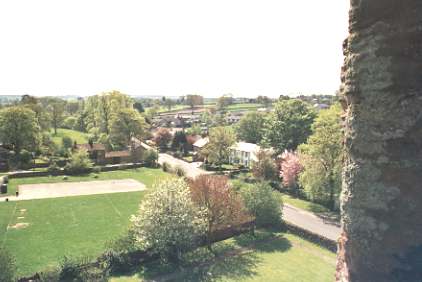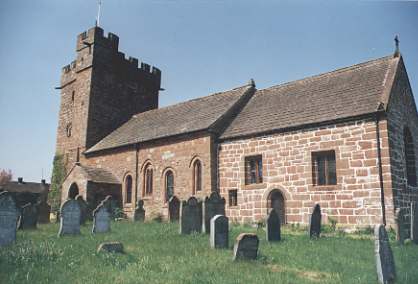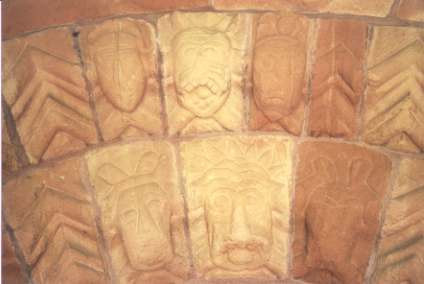The parish of Great Salkeld, which has long
been celebrated for its rural beauties and the extensive and diversified views which it
commands, is bounded on the south by  Eden Hall, on the north and west by
Lazonby, and on the east by the river Eden; and extends about 3½ miles from east to west,
and three miles from north to south. It contains 441 inhabitants, and 3635 rateable acres
of land, of the rateable value of £2906; and the soil, which is very fertile, is mostly
of a light and gravelly nature, except near the Eden, where it has a mixture of loam. The
commons were enclosed under an Act of Parliament, passed in 1803, for enclosing Inglewood Forest. The principal land owners are lieut. Wm.
Youngson, of Bowscar, R. W. Sanderson, Esq., of Nunwick Hall (a beautiful mansion, about
1½ mile from the village), and Mr. John Bowstead, of Beck Bank, but the duke of
Devonshire is lord of the manor, which in some records is called Salkeld Regis,
from its having been in the possession of the English and Scottish crowns. The village of
Great Salkeld is large and pleasantly situated on the western banks of the picturesque
vale of Eden, 5 miles N.N.E. of Penrith, and 3 miles S. of Kirkoswald. Near Salkeld Dyke
are vestiges of an ancient encampment1, 400 yards long and
four yards high; and adjoining to it is a circular basin of water, 50 yards in diameter
and five feet deep, which appears to have been excavated for materials to form the
encampment. At the distance of about a quarter of a mile are the remains of a fortified
station, called Aikton castle, formed of rough stones, without mortar, and now overgrown
with bushes, and at a little distance from this is a tumulus of stones called a raise,
similar to Dunmail Raise2. In the bed of the Eden is a
column of masonry work which is supposed to have been the pier of an ancient bridge, but
there is no bridge here at present, nor has there been in the memory of that very useful
personage the oldest inhabitant.
Eden Hall, on the north and west by
Lazonby, and on the east by the river Eden; and extends about 3½ miles from east to west,
and three miles from north to south. It contains 441 inhabitants, and 3635 rateable acres
of land, of the rateable value of £2906; and the soil, which is very fertile, is mostly
of a light and gravelly nature, except near the Eden, where it has a mixture of loam. The
commons were enclosed under an Act of Parliament, passed in 1803, for enclosing Inglewood Forest. The principal land owners are lieut. Wm.
Youngson, of Bowscar, R. W. Sanderson, Esq., of Nunwick Hall (a beautiful mansion, about
1½ mile from the village), and Mr. John Bowstead, of Beck Bank, but the duke of
Devonshire is lord of the manor, which in some records is called Salkeld Regis,
from its having been in the possession of the English and Scottish crowns. The village of
Great Salkeld is large and pleasantly situated on the western banks of the picturesque
vale of Eden, 5 miles N.N.E. of Penrith, and 3 miles S. of Kirkoswald. Near Salkeld Dyke
are vestiges of an ancient encampment1, 400 yards long and
four yards high; and adjoining to it is a circular basin of water, 50 yards in diameter
and five feet deep, which appears to have been excavated for materials to form the
encampment. At the distance of about a quarter of a mile are the remains of a fortified
station, called Aikton castle, formed of rough stones, without mortar, and now overgrown
with bushes, and at a little distance from this is a tumulus of stones called a raise,
similar to Dunmail Raise2. In the bed of the Eden is a
column of masonry work which is supposed to have been the pier of an ancient bridge, but
there is no bridge here at present, nor has there been in the memory of that very useful
personage the oldest inhabitant.
 The Church3
(St. Cuthbert) consists of a nave, chancel, and tower, with a turret, and a south porch;
and its appearance is much improved by not being disfigured with plaster and whitewash. It
appears to have been erected at different periods; and the tower, which has evidently been
a place of defence for the inhabitants, contains an old iron helmet, a breast-plate, and
other pieces of armour, together with the monumental effigy of a man in the attitude of
prayer. The walls of the church are of great thickness. The door on the south, through
which the nave is entered, is a magnificent specimen of Norman architecture, and is
protected by a porch with a pointed
The Church3
(St. Cuthbert) consists of a nave, chancel, and tower, with a turret, and a south porch;
and its appearance is much improved by not being disfigured with plaster and whitewash. It
appears to have been erected at different periods; and the tower, which has evidently been
a place of defence for the inhabitants, contains an old iron helmet, a breast-plate, and
other pieces of armour, together with the monumental effigy of a man in the attitude of
prayer. The walls of the church are of great thickness. The door on the south, through
which the nave is entered, is a magnificent specimen of Norman architecture, and is
protected by a porch with a pointed arch. On each side are three pillars,
having their capitals and imposts ornamented with scrolls; and on the mouldings of the
arch are three grotesque heads. The tower of the church is supposed to have been built by
archdeacon Close, who lies buried under a large grave stone in the chancel, on the brass
of which was this inscription :-
arch. On each side are three pillars,
having their capitals and imposts ornamented with scrolls; and on the mouldings of the
arch are three grotesque heads. The tower of the church is supposed to have been built by
archdeacon Close, who lies buried under a large grave stone in the chancel, on the brass
of which was this inscription :-
Orate pro anima Stephani Close,
Rectoris et Archidiaconis,
qui mortuns est, A.D. mccccIrr.4
The living is a rectory, in the patronage of the bishop of Carlisle, and since the first foundation of the see it has been annexed to the archdeaconry, consequently the Rev. William Goodenough, M.A. is the present incumbent. The rectory is valued in the king's books at £22 10s. 8d., but is now worth £345 a year. The tithes of the parish have been commuted for an annual rent charge of £315.
In the village is a Presbyterian Chapel, which was built about the year 1710, and is now under the ministry of the Rev. Geo. Chapman. The Methodists have also a chapel here. The Parish School was built in 1686, and, in 1710, had an endowment of £3 per annum, but all its revenues are now lost. The poor stock belonging to the parish amounts to £37, and is of the annual value of £1 10s. which is distributed at Christmas and Easter.
This parish has been the birth-place of many eminent men, amongst whom are Edward Law, first baron Ellenborough, lord chief justice of the King's Bench, who was born here in 1749, and died in 1818, leaving behind him a high character for legal ability; the Rev. George Benson, D.D., a learned dissenting minister, who was born here in 1699, and died in 1762; Dr. Bowstead, the late bishop of Lichfield, who was born here in 1801, and whose father was a respectable farmer in this village. He was nephew to the late Rev. John Bowstead, and brother to Mr. John Bowstead of Beck Bank in this parish, and was remarkable for his piety, charity, and learning, having devoted his entire income to the furtherance of education. He died at Bristol on the 11th of October, 1843. The gallant colonel Moorhouse, who fell at the siege of Bangalore, in the East Indies; Rowland Wetheral, the celebrated mathematician and astronomer, who published his perpetual calculator or almanack about the middle of the last century; and the Revds. Caleb Thomas and John Rotheram were all natives of this parish.
At the house of Mr. John Lamb, of Burrell Green is an ancient brass dish resembling a shield, with an inscription round it, now nearly defaced. Like the celebrated drinking glass of Eden Hall5, this too has a legend and couplet, the latter of which runs thus :-
"If this dish be sold or gi'en,
Farewell the luck of Burrell Green."
Mannix & Whellan, History, Gazetteer and Directory of Cumberland, 1847